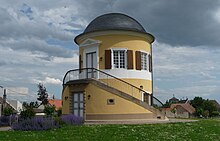Johann Georg Christian Hess
Johann Georg Christian Hess (* 27. February 1756 in Two Bridges , † 26. January 1816 in Frankfurt am Main ) was a German architect of classicism .
life and work
Hess was the son of the Zweibrücken court gunsmith Johann Daniel Hess and his wife Maria Frederica Susanna Hess . He completed an apprenticeship as a bricklayer and then studied from 1774 to 1776 at the Académie Royale de l'Architecture in Paris . In 1778 he became a building authority advisor to the Duke of Zweibrücken . In 1780 he came to Kirchheim an der Weinstrasse as a construction inspector and in 1784 became construction director for the Prince of Salm-Kyrburg . His planning for a Protestant central building church in Kerzenheim / Palatinate from 1783, as well as the Bellevue in the former palace garden in Kleinniedesheim / Palatinate, dates from this time .
In 1785 he was appointed city architect of Frankfurt am Main , but was only able to take up the position in 1787 as the successor to Johann Andreas Liebhardt . Among other things, he revised Liebhardt's design for the new building of the Paulskirche in Frankfurt . The idea of French revolutionary architecture (see Pantheon ) was expressed in the planning . He also designed the Schopenhauerhaus in Frankfurt - later so-called - and destroyed in the Second World War , and in 1809 drafted building regulations for the city of Frankfurt on behalf of Grand Duke Carl Theodor von Dalberg , which in principle remained valid until 1880. Therein was Classical mandatory as architecture and building the outside 1804-1808 looped walls planned emerging new neighborhood. Hess was shaped by the spirit of the Enlightenment and advocated the architecture of classicism radically. He rejected the preservation of medieval buildings in Frankfurt because they did not correspond to his hygienic and aesthetic ideas. With his specifications he had a lasting influence on the architectural development of Frankfurt, even if he was not able to realize all of his ideas. For example, the planned demolition of the old Nikolaikirche in 1805 was not carried out in favor of a modern exhibition hall due to lack of funds. The Eschenheim tower was also to be demolished in 1806: only the objection of the French ambassador, the Comte d'Hédouville , saved the medieval city tower.
Georg Hess was the father of Johann Friedrich Christian Hess , who had been his assistant since 1810 and who was his successor as town architect in 1816. Both were members of the Frankfurter Masonic Lodge Zur Einigkeit . There are no portraits or written records of Johann Georg Christian Hess.
literature
- Wolfgang Klötzer (Hrsg.): Frankfurter Biographie . Personal history lexicon . First volume. A – L (= publications of the Frankfurt Historical Commission . Volume XIX , no. 1 ). Waldemar Kramer, Frankfurt am Main 1994, ISBN 3-7829-0444-3 , p. 324-325 .
Individual evidence
- ^ Roland Hoede: The Paulskirche as a symbol. Quatuor Coronati, Bayreuth and Frankfurt am Main 1999, p. 22f.
| personal data | |
|---|---|
| SURNAME | Hess, Johann Georg Christian |
| ALTERNATIVE NAMES | Hess, Johann Georg Christian |
| BRIEF DESCRIPTION | German architect |
| DATE OF BIRTH | February 27, 1756 |
| PLACE OF BIRTH | Zweibrücken |
| DATE OF DEATH | January 26, 1816 |
| Place of death | Frankfurt am Main |

